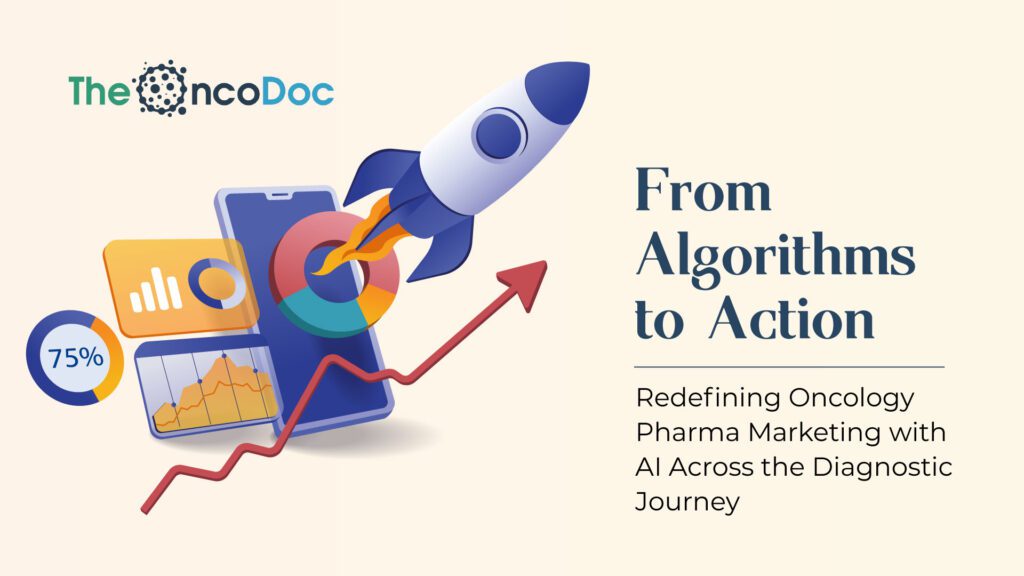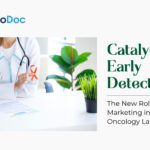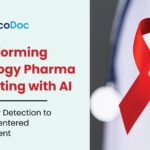Introduction: Ushering in the New Era of Oncology Pharma Marketing
Rapid technical breakthroughs, changing healthcare objectives, and changing patient requirements are all having a significant impact on oncology pharmaceutical marketing. In the post-pandemic landscape, pharmaceutical brands are moving beyond traditional models that primarily focused on promoting late-stage cancer therapies. Today, the approach is far more holistic, addressing the entire oncology care continuum, from population risk identification and early diagnosis to sustained patient engagement, HCP (Healthcare Professional) education, and long-term treatment adherence.
Artificial Intelligence (AI) is at the core of this change. AI is no longer just a technological add-on; it has become a strategic enabler, powering data-driven decisions, personalized communication, and precision targeting. By integrating AI insights with modern digital marketing tactics, pharma companies are redefining how they engage with both HCPs and patients, creating campaigns that are not only clinically relevant but also behaviorally impactful.
This shift is particularly critical for India, where the burden of late-stage cancer diagnoses remains alarmingly high. AI-driven marketing initiatives now offer a two-fold advantage: improving public health outcomes through early intervention while simultaneously strengthening brand trust and recall among medical professionals and patients alike. These campaigns go beyond traditional product promotion, focusing on driving awareness, influencing timely diagnostic decisions, and encouraging proactive referrals.
In this article, we will explore how AI is revolutionizing oncology pharma marketing across five strategic pillars:
- AI-Driven Population Risk Stratification
- Predictive Analytics for Precision HCP Engagement
- AI-Powered Patient Journey Mapping
- Real-Time Content Optimization Using Natural Language Processing (NLP)
- Referral Pathway Acceleration through AI Dashboards and Auto-Nudges
Together, these innovations are helping pharma marketers not just to communicate, but to truly influence outcomes across India’s oncology care landscape.
Section 1: AI-Driven Population Risk Stratification – Marketing Beyond Treatment
Traditional pharma marketing has been centered around product promotion post-diagnosis. AI now allows marketers to target upstream points in the care continuum, particularly population segments at higher risk.
How AI Enables Better Risk Stratification:
· Geo-Spatial Analysis: AI tools map cancer incidence trends across districts and states using hospital registry data and sources like ICMR statistics. This helps pinpoint regions with rising cancer burdens.
· Socio-Demographic Risk Modeling: Algorithms analyze factors such as age, gender, smoking and alcohol habits, dietary patterns, and air quality indices to predict population segments with elevated cancer risk.
· Behavioral Risk Tracking: By monitoring online search patterns for keywords like “breast lump,” “unexplained weight loss,” or “blood in stool,” AI platforms detect emerging symptom hotspots, allowing for timely awareness campaigns.
Marketing Implication:
Pharma marketers can launch hyper-localized awareness campaigns focused on these high-risk clusters, ensuring better engagement and conversion.

(Data Source: Predictive Risk Analytics by Indian Oncology Data Consortium, 2025)
This visualization helps marketers prioritize outreach based on AI-driven risk prediction zones.
Section 2: Precision HCP Engagement – Predictive Analytics for Influencer Targeting
Gone are the days of blanket HCP outreach. AI tools now allow pharma companies to run predictive HCP engagement models to identify:
- Oncologists with the highest referral impact
- General Practitioners in low-referral zones
- Regional HCP influencers active on digital platforms
- Physicians with lagging treatment adoption patterns
AI Capabilities:
- Behavioral clustering: Grouping HCPs by content consumption behavior, prescription history, and peer influence patterns.
- Next Best Action (NBA) modeling: AI suggests optimal channel, timing, and content type for each HCP.
- Sentiment Analysis: NLP algorithms analyze past interactions (emails, webinars, social engagement) to gauge HCP sentiment and readiness.
Tactics for Marketers:
- Deploy micro-segmented email campaigns with AI-recommended content.
- Use AI-guided call scheduling tools for Medical Representatives (MRs).
- Personalize Continuing Medical Education (CME) modules based on AI-detected learning gaps.

(Source: Pharma AI Marketing Dashboard Analytics, Q2 2025)
This data shows how AI-driven targeting significantly boosts engagement among key HCP segments.
Section 3: AI-Powered Patient Journey Mapping; From Symptom Search to Treatment Initiation
AI helps pharma marketers map patient behavior from awareness to diagnosis, offering opportunities for timely interventions.
Touchpoints Captured by AI:
- Search Engine Behavior: Tracking queries like “persistent cough”, “unexplained bleeding”, or “oncology specialists near me”.
- Chatbot Conversations: Mining chat logs from pharma websites and awareness microsites.
- Social Listening: Monitoring patient discussions in online health forums and support groups.
- Telemedicine Records: Analyzing symptom reports from virtual consultation platforms.
Key Marketing Applications:
- Triggering symptom-specific awareness campaigns.
- Deploying AI-powered chatbots that guide patients toward diagnostic centers.
· Delivering SMS notifications for free screening camps based on area.
Mini Case Study:
AI Chatbot Campaign – Cervical Cancer Screening Awareness, Uttar Pradesh (2025)
- Deployed multilingual AI chatbot on WhatsApp and Telegram.
- 1.8 lakh interactions in 4 weeks.
- 14,000+ women booked Pap smear tests.

(Data from Pharma Oncology Patient Journey AI Suite, 2025)
This chart helps visualize the shift towards digital-first patient touchpoints pre-diagnosis.
Section 4: Real-time Content Optimization using Natural Language Processing (NLP)
Content strategy in oncology pharma marketing is evolving rapidly, thanks to advancements in Natural Language Processing (NLP). Static messaging is no longer an option for pharma marketers. Today, AI-powered NLP engines enable real-time content optimization, ensuring each communication is more relevant, personalized, and engagement-driven.
What NLP-Powered Content Engines Enable:
- Dynamic Headline Testing: NLP algorithms evaluate multiple versions of email subject lines, social media captions, and display ad headlines to predict and optimize for higher open and click-through rates (CTR).
- Sentiment Analysis at Scale: NLP tools scan feedback from webinars, surveys, HCP forums, and social media channels to gauge audience sentiment, positive, neutral, or negative, helping marketers refine messaging tone.
- Behavioral Content Personalization: AI-driven segmentation allows pharma marketers to categorize HCPs and patients based on content consumption patterns, digital behaviors, and specialty areas. Each group then receives customized content streams aligned with their interests.
Practical Example:
During a lung cancer awareness campaign, a leading pharma company deployed NLP tools to test three ad formats on digital platforms like Google Display Network and LinkedIn:
- Emotion-Led Storytelling
- Data-Centric Messaging with Survival Statistics
- Urgency-Based Calls-to-Action for Screening
The NLP engine analyzed engagement data in real-time and identified that emotional storytelling generated a 35% higher CTR among Tier 2 city audiences compared to the other formats.
Key Takeaways for Pharma Marketers:
- Implement AI-based A/B testing tools across all digital outreach campaigns.
- Use live dashboard analytics to tweak content mid-campaign for better performance.
- Continuously monitor HCP and patient feedback using NLP to identify emerging concerns, preferred communication styles, and trending topics.
This real-time optimization ensures that every interaction delivers both emotional resonance and scientific relevance.
Section 5: Accelerating Referral Pathways through AI Dashboards and Auto-Nudge Systems
The time gap between symptom onset and specialist referral is one of the biggest barriers in oncology care pathways. AI can help close this gap.
AI Tools Enabling Referral Acceleration:
· Referral Trend Dashboards: These dashboards provide real-time heatmaps highlighting districts or regions with low referral volumes, helping pharma field teams focus educational efforts where gaps exist.
· Automated Nudge Engines: Using rule-based triggers, these engines send timely alerts to GPs who haven’t referred suspected cancer cases, even when patient records show relevant clinical red flags like unexplained weight loss or persistent cough.
· Predictive Referral Scoring: AI models analyze EHR data and chatbot interactions to score patients based on their likelihood of needing an oncology referral. GPs receive follow-up prompts for high-risk patients.
Implementation Tactics:
- Offer HCP referral toolkits with AI-suggested next steps.
- Trigger WhatsApp nudges to GPs about missed referral opportunities.
- Integrate AI referral plugins in telemedicine platforms used in rural areas.
Mini Campaign Example:
Breast Cancer Referral Acceleration – Tamil Nadu, 2025
- Deployed AI referral dashboards across 300 PHCs.
- Sent weekly automated SMS nudges to GPs with low referral counts.
- Achieved a 28% increase in early-stage breast cancer referrals within 3 months.
Section 6: Navigating AI Ethics and Regulatory Compliance in Oncology Pharma Marketing
The adoption of Artificial Intelligence (AI) in oncology pharma marketing unlocks significant opportunities for targeted engagement and improved patient outcomes. However, it also introduces critical ethical and regulatory challenges. As pharma companies leverage AI for HCP targeting, patient education, and referral optimization, ensuring responsible data usage becomes paramount. Maintaining transparency in AI-driven decision-making, securing patient privacy, and avoiding algorithmic bias are now essential to protect stakeholder trust. Furthermore, adherence to changing healthcare laws and digital marketing best practices is essential.
. Pharma marketers must balance innovation with ethical responsibility to sustain credibility and foster long-term relationships with both HCPs and patients.
Key Ethical and Regulatory Considerations for Pharma Marketers:
- Data Privacy Compliance: Strict adherence to India’s Digital Personal Data Protection Act, 2023, is essential. Patient and HCP data collected through AI platforms, be it from chatbots, predictive models, or engagement dashboards, must be stored and processed securely, with clear user consent.
- Content Accuracy and Validation: All AI-generated content for HCPs and patients, including emails, chatbot responses, and educational modules, must undergo thorough medical-legal review. Inaccurate or misleading information could have serious health implications and damage brand reputation.
- Bias Detection and Mitigation: AI algorithms must be regularly audited to eliminate biases based on geography, gender, socio-economic status, or clinical history. Pharma companies should work closely with data scientists to ensure that AI models remain fair, inclusive, and representative of diverse patient populations.
- Transparency and Disclosure: Marketers must clearly communicate when AI tools are being used in decision-making or content delivery. HCPs and patients should be aware when their engagement data is being analyzed or when AI-driven recommendations are being presented.
By embedding these ethical principles into their AI strategies, oncology pharma marketers can build sustainable trust with stakeholders while delivering impactful, compliant, and patient-centric campaigns.
Section 7: Integrating AI with Traditional Marketing Channels; The Omnichannel Future
AI doesn’t replace traditional channels; it enhances them.
Example Omnichannel Oncology Campaign (Breast Cancer Awareness – Mumbai, 2025):
| Channel Type | AI Role | Output |
| Field Force | AI-suggested call priority | 20% increase in productive calls |
| Email Campaigns | AI-optimized subject lines | 30% higher open rates |
| WhatsApp Broadcasts | AI-driven segmentation | Reduced unsubscribe rate by 15% |
| CME Webinars | AI-derived topic recommendations | Improved HCP attendance |
| Social Media Campaigns | NLP-based sentiment tracking | Better engagement targeting |
Marketers who blend AI with traditional pharma tactics will achieve superior outcomes.
Conclusion: From Algorithms to Action – Expanding Pharma’s Role in Oncology Care
Artificial Intelligence (AI) has evolved from being a technological novelty to becoming a transformative force in oncology pharma marketing. It now serves as a critical enabler, helping pharmaceutical companies shift their role from mere product promoters to active stakeholders in improving cancer care outcomes.
AI empowers pharma marketers to engage across the entire oncology care continuum. From accurately identifying high-risk populations using predictive models to enhancing HCP engagement through personalized, data-driven outreach, the opportunities are vast. AI also enables deeper patient journey mapping, providing insights into behavioral patterns, digital touchpoints, and referral bottlenecks. This, in turn, allows for timely interventions that encourage early diagnosis and faster access to care.
Moreover, AI-driven tools like Natural Language Processing (NLP) and real-time analytics platforms help marketers continually refine their messaging, optimize campaign performance, and personalize content delivery, both to HCPs and patients. Referral acceleration tools and automated nudges ensure that the gap between symptom recognition and specialist consultation narrows significantly.
However, with this newfound capability comes responsibility. Ethical data handling, patient privacy compliance, and medically accurate content development remain non-negotiable. Pharma brands must balance innovation with integrity, ensuring that AI-driven campaigns are both impactful and responsible.
The future of oncology marketing lies in embracing AI not just as a tool, but as a mindset, a commitment to improving health outcomes while driving brand relevance. The call to action is clear: pharma must turn algorithms into meaningful actions that help detect earlier, treat faster, and ultimately, save more lives.
The Oncodoc team is a group of passionate healthcare and marketing professionals dedicated to delivering accurate, engaging, and impactful content. With expertise across medical research, digital strategy, and clinical communication, the team focuses on empowering healthcare professionals and patients alike. Through evidence-based insights and innovative storytelling, Hidoc aims to bridge the gap between medicine and digital engagement, promoting wellness and informed decision-making.



